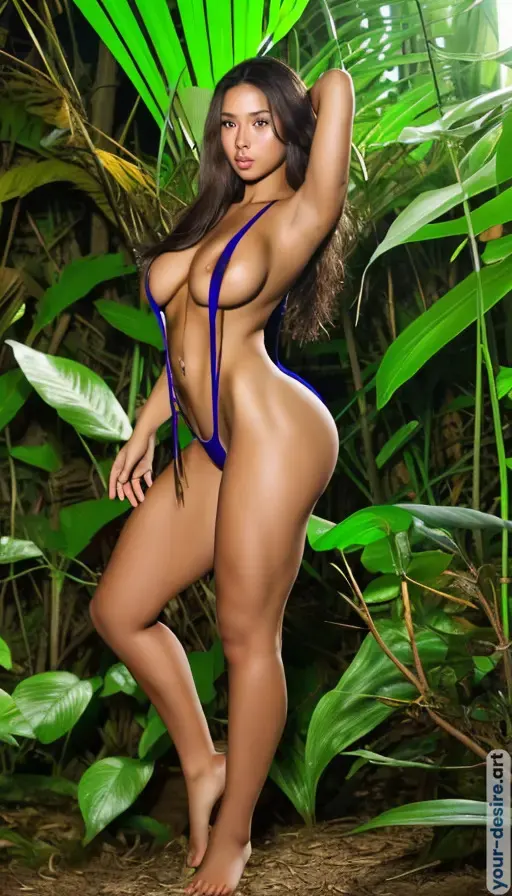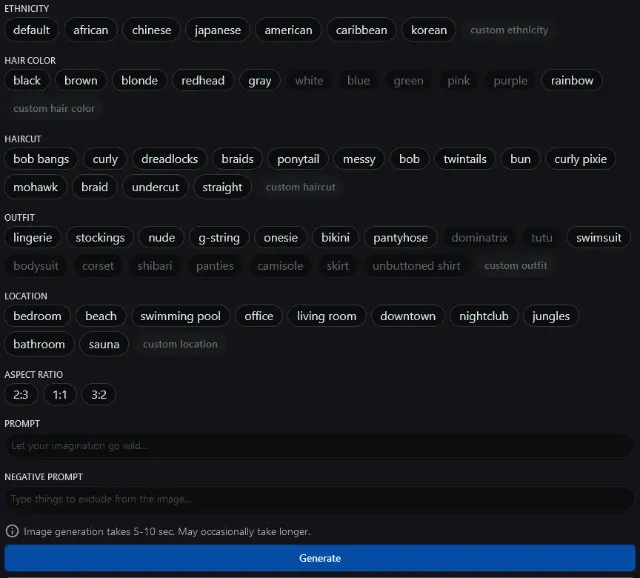The best AI porn sites on the Internet
A few words before you start:
We have divided the site into sections so that there is something for everyone from beginners to advanced players. In addition, we have created a detailed guide that explains exactly how to use AI image generators to get perfect results.
Getting started with AI Porn

Start easy: Tag based image generators
For the advanced: Using tags and prompts
Become a professional: Using prompts
Become an expert: Train your own models
Sites with a special purpose
The comprehensive guide to AI Image generation
Some words for beginners:
AI images are generated by using prompts. You type what you want to see, and the AI is doing its best to generate an image which is close to what you requested. But it's not as easy as it sounds because the AI must interpret the language of the prompt and translate it into visual elements. This process involves complex algorithms that analyze the text to understand the scenes, objects, and styles described. Sometimes the results might not exactly match expectations due to the inherent limitations of AI understanding and creativity. Additionally, the quality and specificity of the prompt can greatly influence the outcome, as more detailed prompts generally lead to better results. Therefore, users often need to refine their prompts through trial and error to achieve the desired image. But ther is another way ....
Start the easy way, just click what you want to see

Tag based image generation
Instead of letting you enter a prompt, which can be quite difficult for a beginner, the website offers a selector for a variety of properties. So you can easily select what you want to see. Like type of person (woman or man), body, hair color, background, and style of art. This user-friendly interface simplifies the process by breaking down complex visual elements into straightforward choices. By selecting these options, users can mix and match characteristics to customize their image without needing to craft a detailed text prompt. This approach not only makes AI art more accessible but also helps in generating more precise outcomes, as the AI has clear parameters to follow based on user selections.
Your next step: from tags to prompt

Add a prompt to tag based image generation
Using tags for image generation is very simple. Just click on what you want to see and the AI image generator will generate a corresponding image. But it is limited to what the tags offer. Therefore, some websites offer the possibility to enter a prompt in addition to the tags. This option allows for more creativity and specificity, enabling users to describe in detail the elements they want in the image that might not be covered by the tags alone. Users can combine both methods to harness the simplicity of tags and the flexibility of text prompts to create more tailored and complex images.
Websites which support tag and prompt based image generationBecome an expert: Using prompts

Mastering prompts
Prompts give you unrestricted access to all the capabilities of the respective AI model. By using prompts, you can generate anything you can imagine. However, using prompts also requires some experience, so your initial results might be somewhat disappointing. Over time and with practice, you will learn how to formulate specific and detailed prompts that lead to improved and more accurate results.
Try some example prompts first. The website PornX.ai publishes images and their prompts, its a good source for inspiration.
Also, pay attention to the negative prompt, which is very important when it comes to excluding unwanted elements. By specifying things that should not appear in the results, you can improve the accuracy and relevance of the generated content. This helps to avoid undesirable topics or inappropriate details, ensuring that the results are better tailored to your specific requirements and guidelines.
Writing the perfect prompt


General introduction
In the fascinating world of artificial intelligence (AI), one of the most captivating advancements is the ability to generate images from textual descriptions. This process transforms a simple text prompt into a vivid, often lifelike image, using sophisticated AI models. Let's delve into the basic concept and the key parameters that shape this process, making it accessible even to beginners who have never generated an AI image before.
From Text to Image
At the heart of AI image generation is the text prompt. This prompt is essentially a detailed description of what you want the image to depict. The AI uses this description as a guide to create a visual representation. For example, if you input "a sunny beach with palm trees," the AI will generate an image that matches this description as closely as possible.
Key Parameters in AI Image Geneartion
Understanding the key parameters helps tailor outputs to your vision.
Text Prompt
The description guiding what the AI generates. Precise prompts yield more accurate images.
Negative Prompt
Specifies what the image should not include, refining the output by eliminating undesired elements.
Image Size
Determines the output's dimensions. Larger sizes offer more detail, while smaller sizes are quicker to generate.
Guidance Scale
djusts the AI's adherence to the prompt. Higher values produce images closer to the prompt, while lower values encourage creativity.
Seed
A numerical value controlling randomness. The same seed and prompt combination produces identical images. This allows the exploration of variations by changing the seed value while keeping the prompt. Or the other way round, keep the seed while chaging the prompt a little to refine an image.

Detailed explanation of AI image generation Parameters
The Prompt
This is like giving instructions or a description to the AI about what you want to see in the image. For example, if you say "a cat sitting on a sunny beach," the AI tries to create just that. Start with a short and clear prompt and develop it further by adding more details.
The Negative Prompt
This is the opposite of a prompt. It tells the AI what you do NOT want in the image. If you don't want any people in your beach scene, you could use a negative prompt like "no people." For AI generated porn try the following as a starting point: disfigured hands, bad hands, additionals arms, additional legs, bad anatomy. You may tailor the prompt to your needs, depending on what the model generated. For further reading you might go here: Fix bad anatomy in Stable Diffusion or Fix Hands in Stable Diffusion
Sampling Steps
Think of "sampling steps" as the number of tries the AI gets to refine or improve the picture it's drawing for you. When the AI starts creating an image based on your prompt, it doesn't get everything right on the first try. So, it goes through the image multiple times, making little adjustments each time to get closer to what you asked for. Sometimes a lower number of sampling steps might be better because sometimes ti AI tends to overefine the image. Numbers 50 to 90 tend to give best results.
Image Size, selecting the correct height and width
This is about how big or what shape the picture is. The size can be square, wide, or tall. It's important because the size should match the scene you're imagining. For a wide beach scene, a wide image works best. For a full-body portrait of someone, a tall image might be better. Also you will get different images when changing the resolution without changing the aspect ratio!
Guidance Scale
Think of this as telling the AI how closely to follow your instructions. A higher number means the AI will try very hard to make exactly what you described, but it might also make the image look a bit strange. A lower number means the AI might not follow your instructions as closely, but the image might look more natural.
The Seed
This is a bit like a recipe number for making your image. If you use the same seed number again with the same instructions, the AI will make the same image again. Use the same image creation parameters with different seeds to create variations of the same image. Our system offers a batch creation option where it keeps the creation parameters and combines these parameters with different seeds.
How to write the perfect prompt
Creating the perfect prompt for AI image generation involves a blend of clarity, detail, and structure. Here’s a guide on crafting effective prompts, divided into sections for easy understanding.
1. Structure of the Prompt
Starting Strong: Begin with the overall scene or main subject. This sets the stage for the details that follow. For example, "A knight standing in a moonlit forest" provides a clear starting point.
Adding Details: After establishing the main subject, incorporate details about the environment, the subject's appearance, posture, and any specific actions. Specify the time of day, weather, and any relevant objects or creatures in the scene.
2. Influencing Clothing and Posture
Clothing: Be specific about the style, era, and details of clothing. Use adjectives and references to well-known styles (e.g., "Victorian-era dress with lace trimmings") to guide the AI.
Posture: Describe the posture by mentioning specific actions or positions (e.g., "sitting cross-legged", "arms raised in triumph"). Clear descriptions of posture help in generating natural, dynamic poses.
3. Enhancing the Environment
Environmental Details: Include descriptions of the setting that influence mood and context (e.g., "under a stormy sky", "surrounded by towering skyscrapers"). Mentioning light sources, such as "bathed in the golden light of sunset", can also guide the AI in creating a more atmospheric image.
Contextual Elements: Adding contextual details (e.g., "a bustling medieval market", "a serene and misty lake") can enrich the background and make the scene more immersive.
4. Fixing Disfigured Anatomy
Anatomical Accuracy: If you notice issues with anatomy in generated images, use more precise descriptions for the affected areas. For example, "hands delicately holding a rose, with fingers clearly defined". You may also direct the AI's attention to certain areas by adding 'detailed face, detailed eyes' to your prompt. Also you can add some things you dont want to see to your negative prompt like: 'Disfigured hands, bad hands, bad anatomy'
5. Using Negative Prompts
Avoiding Unwanted Elements: Clearly state what you do not want in the image (e.g., "no modern buildings", "without any animals"). This helps in refining the output to match your vision.
Correcting Common Mistakes: If the AI frequently makes specific errors (like adding extra limbs), use the negative prompt to directly address these issues (e.g., "no extra limbs").